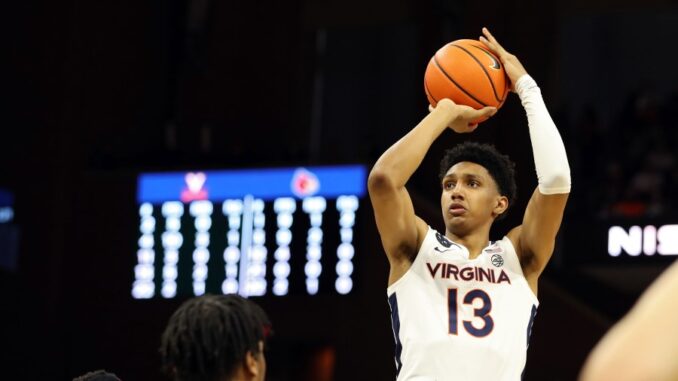
BREAKING NEWS: Carlton Carrington and Ryan Dunn are the Jazz Draft options.
SALT LAKE CITY: Three of the top 32 picks in the 2024 draft belong to the Jazz, giving them multiple chances to bolster their already youthful core.
Take a peek at how Virginia’s Ryan Dunn and Pittsburgh’s Carlton “Bub” Carrington would fit in with the Jazz if they arrive in Utah the following week.
Late First-Round Prospects for the Utah Jazz Draft:
Pitt’s Carlton Carrington, G
13.8 points, 5.2 rebounds, 4.1 assists; shooting percentage of.412/.322/.785
Strengths: At 6-foot-5 and with a 6-foot-9 wingspan, “Bub” Carrington boasts exceptional size for a modern NBA point guard following a late high school growth spurt.
Carrington makes more than half of his field goal attempts from outside the area, averaging over six three-pointers a game.
With his sophisticated ballhandling package, the freshman can create space for open shots from three and mid-range. He can also jump shoot both off the dribble and in spot-up situations.
Even though he only hit 32% from three-point range, there’s cause for optimism that in the NBA, with improved spacing and fewer challenging off-the-dribble tries, his percentages will rise.
Because of his height, Carrington can pass the ball over defensive traps and is a willing skip passer who can locate teammates in the corners for open looks. This makes him an effective perimeter passer.
When it comes to defense, Carrington uses his stature and exceptional wingspan to stop smaller guards from driving, even if they are faster than him.
Weaknesses: Carrington rarely assaults the paint, opting instead to settle for mid-range shots or threes, despite having good size for a lead guard.
Although gaining muscle could help with that problem, he lacks good first step and quickness and struggles to create angles to attack the hoop.
While his average of 4.1 assists per game is by no means concerning, it could have been higher if he had been more aggressive in breaking down defenses and finding teammates for easy baskets in the paint.
Despite his occasional strong play as an on-ball defender, Carrington cannot be regarded as a defensive playmaker because he averages less than 1.0 total blocks and thefts per game.
Similar to the majority of 18-year-olds, Carrington’s potential is primarily theoretical at this time, and it’s possible that he lacks a standout skill that will ensure his NBA survival.
Fit With Jazz: Jordan Clarkson and Keyonte George must be aggressive in their efforts despite their below-average success rates because the Jazz’s current offense mostly relies on off-the-dribble threes.
Carrington might be a very important addition to the Jazz, providing size, playmaking, and pull-up shooting to the current backcourt on the roster, if his percentages improve.
There’s no assurance he will play with the Jazz’s current roster, which includes several players with some of his similar talents and shortcomings, if his shooting doesn’t get better.
Draft Range: 10–25 for the first round.
Virginia’s Ryan Dunn, F
Stats:.548/.200/.532; 8.1 points, 6.9 rebounds, and 0.8 assists.
Strengths: Dunn has the standard size to throw at opposing offensive players at almost every position on the court, making him one of the greatest perimeter defenders to enter the draft in recent seasons.
With a wingspan of seven feet and 1.5 inches and a vertical leap of three feet and eight inches, Dunn possesses an amazing set of skills to be a top defensive player in the NBA.
In addition to having an exceptional physical profile, Dunn also has balance, footwork, recovery time, and spacing awareness that are much above normal for most 21-year-olds.
The Virginia forward is incredibly skilled at rebounding to stop drives as a help defender, staying in the paint to block three-point shooters, and never losing his balance to allow closeouts.
In just 27 minutes a game, Dunn records 2.3 blocks, 1.3 steals, and a ton of deflections when he’s got the ball. He’s also a fantastic rebounder for his position.
Even though he only had one assist on average per game, Dunn found cutters close to the hoop with some interesting passes inside the Virginia attack.
Weaknesses: Dunn may not be as good an offensive player as he is an excellent defender.
The forward scored a little over eight points a night on average, with transition baskets, putbacks, and easy finishes around the rim in pick and roll plays accounting for the majority of his total.
Throughout his two collegiate seasons, Dunn made just 12 three-pointers overall, and he never made more than two in a single game.
It is unlikely that the forward’s shooting percentage of 53 percent will increase significantly, and even if it does, it will probably take several years for him to reach peak performance.
Despite his excellent defense, Dunn might be a difficult player to find a job for in the modern NBA because of how much floor spacing is valued.
Fit With Jazz: If Dunn is still available with the 29th or 32nd pick, the Jazz might want to avoid making the same mistake they did the last two years when they passed on players like Herb Jones and Jaden McDaniels.
Dunn could be able to establish himself as an offensive screen-and-roll option and transition threat even if he never becomes the type of player that shoots forty percent of his threes like McDaniels and Jones do.
The Jazz might use a player who doesn’t demand offensive rebounds because they have a number of willing shooters on the team, but it could be awkward to have him play with other non-shooters.
Draft Range: Picks 20–40, late first and early second rounds.
Leave a Reply